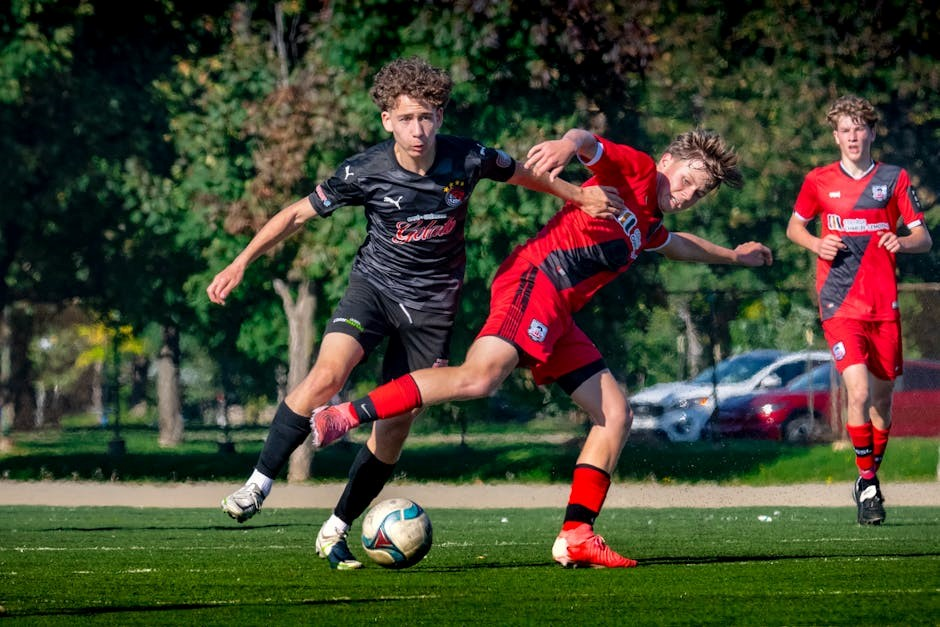
6-2 defense playbook pdf
Overview of the 6-2 Defense in Youth Football
The 6-2 defense is a popular and effective strategy in youth football. It is designed to fortify the line of scrimmage. This alignment is particularly effective against run-heavy offenses common at this level. It provides a simplified approach to defensive assignments for younger players.

Why the 6-2 Defense is Popular in Youth Football
The 6-2 defense gains popularity in youth football for several compelling reasons‚ primarily its simplicity and effectiveness against prevalent offensive strategies. Many youth teams favor running plays‚ making a strong run-stopping defense highly valuable. The 6-2 formation naturally loads the box with extra defenders near the line of scrimmage‚ providing a numerical advantage to counter rushing attacks.
This defensive setup simplifies coaching. Each player typically has a clear gap responsibility‚ making it easier for young athletes to understand and execute their roles. This clarity reduces confusion and allows players to react quickly and confidently. It’s easier to install‚ making it a good starting point for coaches new to the game or working with less experienced players.
Furthermore‚ the 6-2 defense allows coaches to place their best athletes at linebacker‚ where they can freely roam and make plays. With six down linemen occupying blockers‚ the linebackers have more opportunities to pursue the ball carrier and disrupt the offense. This defense is particularly beneficial when a team has limited depth at linebacker‚ as it maximizes the impact of their strongest players in those crucial positions‚ enabling them to focus on stopping the run.

Key Principles and Techniques in the 6-2 Defense
The 6-2 defense hinges on several key principles and techniques crucial for its successful execution. At its core‚ gap control forms the foundation‚ with each lineman responsible for a specific gap along the offensive line. Proper technique in engaging blockers‚ maintaining leverage‚ and shedding blocks is essential for controlling these gaps and preventing the offense from gaining easy yardage.
Defensive line techniques focus on quickness off the ball‚ low pad level‚ and hand placement to control the offensive lineman. Linebackers must possess excellent read-and-react skills‚ quickly diagnosing the play and filling the assigned gap. Their tackling technique must be sound‚ emphasizing wrapping up and driving through the ball carrier to prevent broken tackles and ensure secure stops.
Communication is paramount in the 6-2 defense. Players must clearly communicate pre-snap adjustments‚ potential blitzes‚ and any shifts in offensive formation. This ensures everyone is aligned correctly and prepared for the play. The defensive ends must prioritize containing the outside run and preventing the quarterback from escaping the pocket. The emphasis is on aggressive‚ disciplined play within assigned roles‚ working cohesively as a unit to shut down the opponent’s running game.
Gap Responsibilities in a Standard 6-2 Formation
In a standard 6-2 formation‚ each defensive player has specific gap responsibilities crucial to the defense’s success. The defensive tackles are primarily responsible for the A gaps‚ which are the spaces between the center and the guards. They must penetrate quickly and disrupt the offensive line‚ preventing the running back from hitting the hole. The defensive ends are tasked with containing the outside run and are responsible for the C gaps‚ located outside the offensive tackles. They must prevent the ball carrier from getting to the edge and turning the corner.
The inside linebackers typically have the B gap responsibilities‚ which are the spaces between the guards and the tackles. They must read the offensive line and quickly fill the appropriate gap‚ making sure tackles on any runs up the middle. The cornerbacks are usually assigned man coverage on the wide receivers. They also must be prepared to support the run by containing the outside when the ball carrier breaks contain.
The free safety typically plays deep and is responsible for providing help over the top‚ preventing any long passes. The free safety must be a sound tackler and be able to support the run. Clear communication and discipline are key for everyone.

Player Positioning and Roles in the 6-2 Defense
In the 6-2 defense‚ precise player positioning and well-defined roles are essential for its effectiveness‚ particularly in youth football. The six defensive linemen‚ typically consisting of two defensive tackles and two defensive ends‚ position themselves along the line of scrimmage. The defensive tackles usually align in the A gaps‚ focusing on disrupting the center-guard combination and plugging up the middle. Their primary role is to stop inside runs and apply pressure on the quarterback if the opponent attempts a pass.
The defensive ends line up in the C gaps‚ aiming to control the outside and prevent runs to the perimeter. They are also responsible for containing the quarterback on pass plays‚ forcing him to stay inside the pocket. Behind the defensive line‚ two linebackers fill crucial roles‚ reading the play and reacting quickly to either run or pass. Their positioning allows them to flow to the ball‚ filling gaps and making tackles.
The secondary consists of cornerbacks and a safety‚ providing coverage against the pass. The cornerbacks usually play man-to-man on the receivers while the safety provides deep support and helps against the run. Each player must understand their role and execute it effectively.
Adjustments to Offensive Formations in the 6-2
The 6-2 defense requires adaptability. Coaches often adjust alignments based on offensive formations. Shifts‚ blitzes‚ and zone coverages are employed to counter varied threats. Understanding the offensive strategy is key to making successful pre-snap and post-snap adjustments.
Handling Trips Formations
When facing trips formations‚ the 6-2 defense requires specific adjustments to maintain its integrity and effectiveness. A “trips” formation‚ characterized by three receivers aligned on one side of the offensive line‚ can create significant challenges for a defense primarily designed to stop the run. One common approach involves shifting the defensive line and linebackers towards the trips side‚ overloading that side of the field to provide additional run support and pass coverage.
The cornerback aligned to the trips side often needs to play with outside leverage‚ forcing the outside receiver inside and relying on safety help over the top. The safety’s role becomes crucial‚ as they must be prepared to quickly react to both run and pass plays‚ providing deep zone coverage and support against crossing routes. Communication between the cornerback and safety is paramount to avoid mismatches and ensure proper coverage assignments.
Another adjustment involves assigning specific coverage responsibilities to the linebackers. One linebacker might be tasked with covering the inside receiver in the trips formation‚ while the other linebacker focuses on the running back or potential crossing routes. Coaches may also implement blitz packages designed to pressure the quarterback quickly‚ disrupting the timing of pass plays and forcing errant throws. The key to successfully defending trips formations with the 6-2 defense is disciplined execution‚ clear communication‚ and adaptable strategies that address both the run and pass threats.
Strengths of the 6-2 Defense
The 6-2 defense shines in its ability to control the line of scrimmage. It is well-suited to shut down the run. With six players near the line‚ it overloads the point of attack. This makes it hard for offenses to gain yards on the ground.
Run Stopping Capabilities
The 6-2 defense is renowned for its exceptional run-stopping capabilities‚ making it a favorite in youth football where ground-based offenses prevail. The alignment‚ featuring six defensive linemen and two linebackers‚ creates a formidable wall at the line of scrimmage. This dense front makes it challenging for opposing teams to establish a consistent running game.
Each defensive lineman is assigned a specific gap responsibility‚ ensuring that every potential running lane is accounted for. This disciplined approach minimizes opportunities for offensive breakthroughs‚ forcing runners into tightly contested areas where they are quickly met by aggressive defenders. The two linebackers play a crucial role in filling any gaps that may emerge‚ providing additional support against the run.
Furthermore‚ the 6-2’s inherent strength lies in its ability to disrupt blocking schemes‚ preventing offensive linemen from effectively opening holes for the ball carrier. The sheer number of defenders engaged at the line creates confusion and overwhelms blocking assignments‚ leading to tackles for loss and minimal yardage gains. This dominance at the point of attack allows the defense to dictate the flow of the game. This is especially advantageous in youth football where skill level can differ.
Weaknesses of the 6-2 Defense
While the 6-2 defense excels at stopping the run‚ it does have vulnerabilities. Primarily‚ it can be susceptible to passing attacks. With only three defensive backs‚ coverage can be stretched thin. This makes it important to have skilled cornerbacks.
Susceptibility to the Pass
The 6-2 defense‚ while strong against the run‚ inherently possesses a weakness against competent passing offenses. The alignment typically features only three defensive backs‚ two cornerbacks‚ and a safety. This limited secondary coverage can be exploited by teams with skilled receivers and quarterbacks capable of making accurate throws.
Opposing offenses may seek to isolate receivers in one-on-one situations‚ particularly against cornerbacks who lack the speed or experience to consistently win those matchups. The deep middle of the field can also become vulnerable‚ as the lone safety is often tasked with covering a significant amount of territory.
Furthermore‚ play-action passes can be particularly effective against the 6-2. Linebackers aggressively pursuing the run may be caught out of position. This creates open throwing lanes for quarterbacks. Coaches employing the 6-2 must be aware of this vulnerability and implement strategies to mitigate the risk. This means focusing on pass coverage and strategic blitzes.
Adjustments such as zone coverages and linebacker drops can help provide additional support in pass defense. However‚ these adjustments can sometimes weaken the defense’s run-stopping capabilities. Therefore‚ a balanced approach is necessary to effectively counter both running and passing plays.
Coaching Tips for Implementing the 6-2 Defense
Implementing the 6-2 defense in youth football requires a focus on fundamentals and clear communication. Start by teaching players their specific gap responsibilities. Ensure each player understands their role in stopping the run. Emphasize proper tackling techniques. Safe and effective tackling is crucial for preventing injuries and maximizing defensive success.
Next‚ focus on linebacker play. Select your two best athletes for these positions. Linebackers must be able to read the play quickly‚ fill gaps aggressively‚ and make tackles. Run drills that simulate various offensive formations and plays. This will help linebackers develop their instincts and decision-making skills.
Pay close attention to the defensive line. Ensure they maintain a low pad level and use proper hand placement to control offensive linemen. Work on pass-rushing techniques to create pressure on the quarterback‚ even though the 6-2 is primarily a run-stopping defense.
Regularly review game film with your players. This helps them identify areas for improvement and understand how their individual performance contributes to the overall defensive strategy. Encourage players to ask questions and provide feedback.
Finally‚ be patient and adapt your coaching style to the needs of your players. Youth football is about development‚ not just winning. Focus on teaching the fundamentals. Create a positive learning environment. The 6-2 can be a highly effective defense when implemented correctly.

Variations of the 6-2 Defense in Youth Football
While the standard 6-2 defense provides a solid foundation‚ several variations can be employed to adapt to different offensive schemes and player skill sets in youth football. One common variation involves adjusting the alignment of the defensive line. For example‚ a “6-2 Wide Tackle” shifts defensive tackles further outside‚ aiming to disrupt outside runs and force the play inside.
Another variation focuses on linebacker blitzes. Bringing one or both linebackers on a blitz can create additional pressure on the quarterback or disrupt running plays in the backfield. However‚ this requires careful planning and communication to avoid leaving gaps in the defense.
Teams might also implement different coverage schemes behind the 6-2 front. While man coverage is common‚ zone coverage can be used to protect against the pass‚ especially if the opposing team has skilled receivers. A “Cover 3” scheme‚ where the field is divided into three deep zones‚ can be effective in limiting deep throws.
Furthermore‚ adjustments can be made based on offensive formations. Against trips formations‚ the defense might shift the linebackers towards the trips side or adjust coverage responsibilities to account for the extra receivers. Flexibility and adaptability are key to maximizing the effectiveness of the 6-2 defense and responding to different offensive challenges.